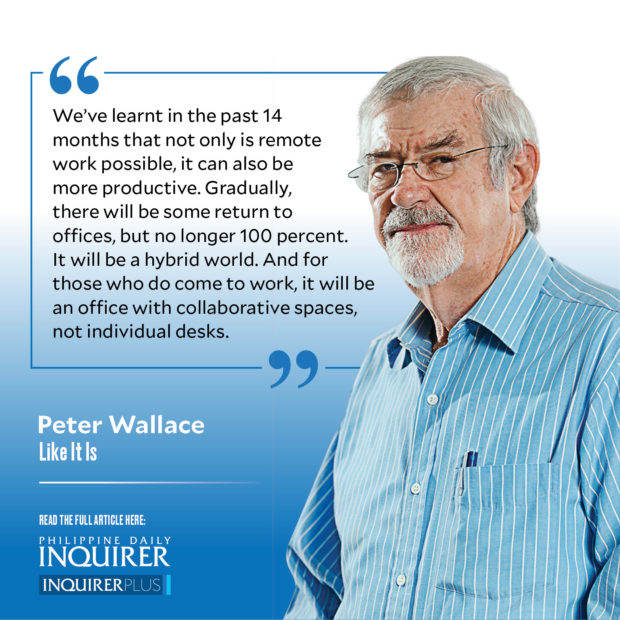
The Wallace Business Forum, together with Cisco, recently held a series of webinars via Webex, focusing on the changes that are occurring in the workplace. Webex is a vastly superior tool for holding a webinar. With noise suppression, you hear my voice but not my three German Shepherds barking.
We’ve learnt in the past 14 months that not only is remote work possible, it can also be more productive. Gradually, there will be some return to offices, but no longer 100 percent. It will be a hybrid world. And for those who do come to work, it will be an office with collaborative spaces, not individual desks.
Workers want more control and choice. Based on the Cisco Workforce of the Future Study survey in the Philippines, 18 percent worked from home most of the time before the pandemic. Now, 93 percent want greater ownership and choice in this new world of work. Employees want to have the choice of deciding how many days they work from home, and how many in the office.
Because of the pandemic, cultural norms in the workplace have also been challenged. The same Cisco survey showed that 87 percent say there is now proof that employees don’t need to be in the same room to collaborate; 83 percent incorporated more exercise in their daily routine; 66 percent want to travel less; and 51 percent felt trust from leaders improved.
The future of work is hybrid. Some people will work from home. Some from the office. Some from anywhere like coffee shops or beach houses. Some 98 percent of meetings in the future will include remote participants, and 53 percent of organizations will reduce and reimagine their office with more collaborative spaces.
According to Cisco, for hybrid work solutions to be effective, they must be: inclusive (provide equal experiences for everyone), flexible (able to adapt to any work style, role, and environment), supportive (focused on empathy and the well-being of employees), secure (secure by design), and well-managed (features modern infrastructure and frictionless administration).
To adapt in the hybrid world, companies need to invest in appropriate technology so that the workforce can function efficiently and effectively. This includes training of personnel to keep them up to date on new technological developments and allow them to meet customer expectations.
It is also important for companies to redefine rules, roles, and responsibilities and to adapt to a performance output regime, no longer on a fixed schedule of 9 to 5. Management has learned to trust that employees can deliver work even when they are not in the office. It should become an outcome-based mindset.
Another key takeaway is that companies will need strong leadership who can recognize talent and develop diverse teams in a hybrid world. It is crucial for management to learn and adapt fast to the changes that are occurring. Managers in a hybrid workplace need to be clear on the purpose of the workplace and what it stands for, ensure the physical safety and health of employees, and pay more attention to the mental health of workers. Companies need to create an inclusive environment.
There will be a rise of smart buildings and smart workplaces, where handling data will be central to the emerging workplace considerations. According to Knight Frank Global Research, the future office will have: less desks and more collaborative work settings; less formal meeting rooms and more flexible project rooms; less conference spaces and more hybrid event spaces; less teleconferencing rooms and more video conferencing rooms; less printers and more virtual workspaces; less fixed workstations and more shared workbenches; and less monotony and more variety.
We will have to learn how to be more sophisticated in our ways of communication, to somehow make the virtual more personal. In part, that means better cameras and microphones, the ability to see more of a person than a face where hand gestures are lost.
One of the amusing things that has come out of all this is: What happens to the company car? And to the other perks of the office—free coffee and doughnuts, for instance.
The office is not dead. But the office is no longer a place you go to to work. The office is a place you go to to collaborate.
Email: wallace_likeitis@wbf.ph